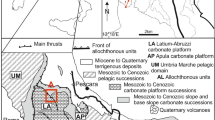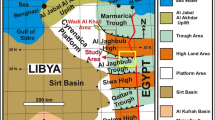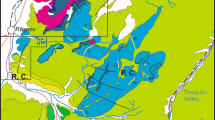Abstract
Facies associations of the Rhaetian Fatra Formation from the Veľká Fatra Mts. (West Carpathians) were deposited in a storm-dominated, shallow, intra-platform basin with dominant carbonate deposition and variable onshore peritidal and subtidal deposits, with 21 microfacies types supported by a cluster analysis. The deposits are formed by bivalves, gastropods, brachiopods, echinoderms, corals, foraminifers and red algae, ooids, intraclasts and peloids. A typical feature is the considerable variation in horizontal direction. The relative abundance and state of preservation of components as well as the fabric and geometric criteria of deposits can be correlated with depth/water energy-related environmental gradients. Four facies associations corresponding to four types of depositional settings were distinguished: a) peritidal, b) shoreface, above fair-weather wave base (FWWB), c) shallow subtidal, above normal storm wave base and d) above maximum storm wave base. The depositional environment can be characterized as a mosaic of low-relief peritidal flats and islands, shoreface banks and bars, and shallow subtidal depressions. The distribution and preservation of components were mainly controlled by the position of base level (FWWB), storm activity and differences in carbonate production between settings. Poorly or moderately diverse level-bottom macrobenthic assemblages are dominated by molluscs and brachiopods. The main site of patch-reef/biostrome carbonate production was located below the fair-weather wave base. Patch-reef/biostrome assemblages are poorly diverse and dominated by the branched scleractinian coral Retiophyllia, forming locally dm-scale autochthonous aggregations or more commonly parautochthonous assemblages with evidence of storm-reworking and substantial bioerosion by microborings and boring bivalves.
Facies types and assemblages are comparable in some aspects to those known from the Upper Triassic of the Eastern and Southern Alps (Hochalm member of the Kössen Formation or Calcare di Zu Formation), pointing to similar intra-platform depositional conditions. The absence of large-scale patch-reefs and poor diversity of level-bottom and patch-reef/biostrome assemblages with abundance of eurytopic taxa indicate high-stress/unstable ecological conditions and more restricted position of the Fatric intra-platform setting from the open ocean than the intra-platform habitats in the Eastern or Southern Alps.

















Similar content being viewed by others
References
Aigner T (1982) Calcareous tempestites: storm-dominated stratification in Upper Muschelkalk limestones (Middle Trias, SW-Germany). In: Einsele G, Seilacher A (eds) Cyclic and event stratification. Berlin-Heidelberg-New York, pp 180–198
Aigner T (1985) Storm depositional systems. Dynamic stratigraphy in modern and ancient shallow marine sequences. Lecture Notes Earth Sc 3: 1-174
Aigner T, Hagdorn H, Mundlos R (1978) Biohermal, biostromal and storm-generated coquinas in the Upper Muschelkalk. N Jahrb Geol Paläont, Abh 157:42–52
Bacelle L, Bosellini A (1965) Diagrammi per la stime visiva della composizione percentuale nelle rocce sedimentaire. Ann Univ Ferrara, Sci Geol Paleont 1:59–62
Ball MM (1967) Carbonate sand bodies of Florida and the Bahamas. J Sedim Petrol 37: 556–591
Bernecker M, Weidlich O, Flügel E (1999) Response of Triassic reef coral communities to sea-level fluctuations, storms and sedimentation: evidence from a spectacular outcrop. Facies 40:229–280
Borza K (1975) Mikroproblematika aus der oberen Trias der Westkarpaten. Geol Zb Geol Carpath 26: 199–236
Burchette TP, Wright VP (1992) Carbonate ramp depositional systems. Sedim Geol 79:3-57
Cram JM (1979) The influence of continental shelf width on tidal range: paleoceanographic implications. J Geol 87:441–447
Duffin CJ, Gadzicki A (1977) Rhaetian fish remains from the Tatra Mountains. Acta Geol Polon 27: 333–348
Dullo WC (1980) Paläontologie, Facies und Geochemie der Dachsteinkalke (Obertrias) im südwestlichen Gesäuse, Steiermark, Österreich. Facies 2:55–122
Dunham RJ (1962) Classification of carbonate rocks according to depositional texture. Mem AAPG 1:108–121
Ehses HH, Leinfelder RR (1988) Laterale und vertikale Faziesentwicklung der Rhät/Unterlias-Sedimentation im Wallberg-Blankenstein-Gebiet (Tegernsee, Nrdliche Kalkalpen). Mainz Geowiss Mitt 17: 53–94
Enos P, Samankassou E (1998) Lofer cyclothems revisited (Late Triassic, Northern Alps, Austria). Facies 38: 207–228
Embry AF, Klovan JE (1972) Absolute water depth limits of Late Devonian paleoecological zones. Geol Rund 61:672–686
Fischer AG (1964) The Lofer cyclothems of the alpine Triassic. Kansas Geol Surv Bull 169: 107–149
Flügel E (1972) Mikroproblematika in Dünnschliffen von Trias-Kalken. Mitt Ges Geol Bergbaustud 21:957–988
Flügel E (1981) Paleoecology and facies of Upper Triassic reefs in the Northern Calcareous Alps. In: Toomey DF (ed) European fossil reef models. SEPM Spec Publ 30: 291–359
Flügel E (2002) Triassic reef patterns. In: Kiessling W, Flügel E, Golonka J (eds) Phanerozoic reef patterns. SEPM Spec Publ 72:391–463
Flügel E, Kiessling W (2002) Patterns of Phanerozoic reef crises. In: Kiessling W, Flügel E, Golonka J (eds) Phanerozoic reef patterns. SEPM Spec Publ 72:691–733
Gaffey SJ (1983) Formation and infilling of pits of marine ooid surfaces. J Sedim Petrol 53: 193–208
Garrett P (1970) Phanerozoic stromatolites – non-competitive ecologic restriction by grazing and burrowing animals. Science 169:171–173
Gawlick, HJ (2000) Paläogeographie der Ober-Trias Karbonattplatform in den Nordlichen Kalkalpen. Mitt Ges Geol Bergbaustud Österr 44: 45–95
Gadzicki A (1971) Megalodon limestones in the subtatric Rhaetian of the Tatra Mts. Acta Geol Polon 21:387–398
Gadzicki A (1974) Rhaetian microfacies, stratigraphy and facial development in the Tatra Mts. Acta Geol Polon 24: 17–96
Gadzicki A (1983) Foraminifers and biostratigraphy of Upper Triassic and Lower Jurassic of the Slovakian and Polish Carpathians. Palaeont Polon 44: 109–169
Gadzicki A, Michalík J, Planderová E, Sýkora M (1979) An Upper Triassic—Lower Jurassic sequence in the Krížna nappe (West Tatra Mountains, West Carpathians, Czechoslovakia). Záp Karp, Geol 5: 119–148
Golebiowski R (1991) Becken und Riffe der alpinen Obertrias—Lithostratigraphie und Biofazies der Kossener Formation. Exkursionen Jungpaläozoikum und Mesozoikum, Österr, Österr Paläont Gesell, pp 79–119
Haas J, Kovács S, Krystyn L, Lein R (1995) Significance of Late Permian-Triassic facies zones in terrane reconstructions in the Alpine-North Pannonian domain. Tectonophysics 242:19–40
Hallam A (1996) Recovery of the marine fauna in Europe after the end-Triassic and early Toarcian mass extinctions. In: Hart MB (ed) Biotic recovery from mass extinction events. Geol Soc Lond Spec Publ 102: 231–236
Hallam A (2002) How catastrophic was the end-Triassic mass extinction? Lethaia 35:147–157
Hallam A, Wignall PB (1997) Mass extinctions and their aftermath. Oxford Univ Press, Oxford, 320 pp
Hallock P (1988) The role of nutrient availability in bioerosion: consequences to carbonate buildups. Palaeogeogr, Palaeoclimatol, Palaeoecol 63:275–291
Hallock P, Schlager W (1986) Nutrient excess and the demise of coral reefs and carbonate platforms. Palaios 1:389–398
Hardie LA (1996) Secular variation in seawater chemistry: an explanation for the coupled secular variation in the mineralogies of marine limestones and potash evaporites over the past 600 m.y. Geology 24:279–283
Hill MO, Gauch HG Jr (1980) Detrended correspondence analysis: an improved ordination technique. Vegetatio 42:47–58
Hine AC (1977) Lily Bank, Bahamas: history of an active oolite sand shoal. Journal Sedim Petrol 47:1-25
Hine AC, Wilber RJ, Neumann AC (1981) Carbonate sand bodies along contrasting shallow bank margins facing open seaways in Northern Bahamas. AAPG Bull 65:261–290
Inden RF, Moore CH (1983) Beaches. In: Scholle PA, Bebout DG, Moore CH (eds) Carbonate depositional environments. AAPG Memoir 33:211–265
Kazmierczak J, Colemn ML, Gruszczynski M, Kempe S (1996) Cyanobacterial key to the genesis of micritic and peloidal limestones in ancient sea. Acta Palaeont Polon 41:319–388
Kenkel NC, Orlóci L (1986) Applying metric and nonmetric multidimensional scaling to ecologic studies. Some new results. Ecology 67:919–928
Kidwell SM, Bosence DWJ (1991) Taphonomy and time-averaging of marine shelly faunas. In: Allison PA, Briggs DEG (eds) Taphonomy: Releasing the data locked in the fossil record. Plenum Press, New York, pp 115–129
Klein G De V, Ryer TA (1978) Tidal circulation patterns in Precambrian, Paleozoic, and Cretaceous epeiric and mioclinal shelf seas. Geol Soc Am Bull 89:1050–1058
Kobluk DR, Risk MJ (1977) Micritization and carbonate-grain binding by endolithic algae. AAPG Bull 61:1069–1082
Kochanová M (1967) Zur Rhaet-Hettang-Grenze in den Westkarpaten. Sb Geol Vied, Záp Karpaty 7:7-102
Kołodziej B (1997) Boring Foraminifera from exotics of the Štramberk-type limestones (Tithonian-Lower Berriasian, Polish Carpathians). Ann Soc Geol Polon 67:249–256
Kowalewski M, Gürs K, Nebelsick JH, Oschmann W, Piller WE, Hoffmeister AP (2002) Multivariate hierarchical analyses of Miocene mollusk assemblages of Europe: paleogeographic, paleoecological, and biostratigraphic implications. Geol Soc Am Bull 114: 239–256
Kuss J (1983) Faziesentwicklung in proximalen Intraplatform-Becken: Sedimentation, Palökologie und Geochemie der Kössener Schichten (Ober-Trias, Nördlichen Kalkalpen). Facies 9:61–172
Lakew T (1990) Microfacies and cyclic sedimentation of the Upper Triassic (Rhaetian) Calcare di Zu (Southern Alps). Facies 22: 187–232
Lescinsky HL (2001) Epibionts. In: Briggs DEG, Crowther PR (eds) Palaeobiology II. Blackwell Sc, Oxford, pp 460–464
Michalík J (1973) Paläogeographische Studie des Räts der Krížna-Decke des Strážov-Gebirges und einiger anliegender Gebiete. Geol Zb Geol Carpath 24: 123–140
Michalík J (1974) Zur Paläogeographie der Rhätische Stufe des weslichen Teiles der Krížna-Decke in der West-Karpaten. Geol Zb Geol Carpath 25: 257–285
Michalík J (1975) Genus Rhaetina Waagen, 1882 (Brachiopoda) in the Uppermost Triassic of the West Carpathians. Geol Zb Geol Carpath 26: 47–76
Michalík J (1977) Paläogeographische Untersuchungen der Fatra-Schichten (Kossen - Formation) des nordlichen Teiles des Fatrikums in der Westkarpaten. Geol Zb Geol Carpath 28:71-94
Michalík J (1979) Paleobiogeography of the Fatra-Formation of the Uppermost Triassic of the West Carpathians. Paleont Konf 77, Charles University, Prague, pp 25–39
Michalík J (1980) A paleoenvironmental and paleoecological analysis of the West Carpathian part of the Northern Tethyan nearshore region in the Latest Triassic time. Riv Ital Paleont 85: 1047–1064
Michalík J (1982) Uppermost Triassic Short-Lived Bioherm Complexes in the Fatric, Western Carpathians. Facies 6: 129–146
Michalík J (1985) Bystrý Potok. Litofaciálny vývoj rétskeho súvrstvia. In: Samuel O, Franko O (eds) Sprievodca k XXV. celoštátnej geologickej konferencii Slovenskej geologickej spoločnosti. Geol. Ústav. D. Štúra, pp 168–170
Michalík J (1994) Notes on the paleogeography and paleotectonics of the Western Carpathian area during the Mesozoic. Mitt Österr Geol Gesell 86:101–110
Michalík J, Gadzicki A (1983) Stratigraphic and environmental correlations in the Fatra- and Norovica Formation (Upper Triassic, Western Carpathians). Schrift Erdwiss Komm 5: 267–276
Michalík J, Jendrejáková O (1978) Organism communities and biofacies of the Fatra Formation (Uppermost Triassic, Fatric) in the West Carpathians. Geol Zb Geol Carpath 29: 113–137
Michalík J, Sýkora M (1979) Fatra- und Kopienec-Schichten in dem Profil Ráztoky des Nolčovo-Tales in der Grossen Fatra Gebirge (höchste Trias-untere Jura des Krížna-Decke, Westkarpaten). Kmetianum, 5:113–133
Mišík M (1997) Stratigraphical and spatial distribution of limestones with calcite, chamosite, hematite and illite ooids in the Western Carpathians. Miner Slov 29: 83–112 (in Slovak with English summary)
Perry CT (1998) Grain susceptibility to the effects of microboring: implications for the preservation of skeletal carbonates. Sedimentology 45:39–51
Perry CT (1999) Reef framework preservation in four contrasting modern reef environments, Discovery Bay, Jamaica. J Coast Res 15:796–812
Perry CT, Bertling M (2000) Spatial and temporal patterns of macroboring within Mesozoic and Cenozoic coral reef systems. In: Insalaco E, Skelton PW, Palmer TJ (eds) Carbonate platform systems: components and interactions. Geol Soc Lond Spec Publ 178:33–50
Piller W (1981) The Steinplatte reef complex, part of an Upper Triassic carbonate platform near Salzburg, Austria. In: Toomey DF (ed) European fossil reef models. SEPM Spec Publ 30: 261–290
Pratt BR, James NP (1986) The St George Group (Lower Ordovician) of western Newfoundland: tidal flat island model for carbonate sedimentation in shallow epeiric seas. Sedimentology 33: 313–343
Rakús M (1993) Lias ammonites of the West Carpathians. Zap Karpaty Paleont 17:7-40
Raup DM, Sepkoski JJ Jr (1982) Mass extinctions in the marine fossil record. Science 215:1501–1503
Raup DM, Sepkoski JJ Jr (1986) Periodic extinction of families and genera. Science 231:833–836
Reyment RA, Savazzi E (1999) Aspects of multivariate statistical analysis in geology. Elsevier, Amsterdam, 285 pp
Roniewicz E, Michalík J (1991a) A new Triassic scleractinian coral from the High Tatra Mountains (Western Carpathians, Czecho-Slovakia). Geol Carpath 42: 157–162
Roniewicz E, Michalík J (1991b) Zardinophyllum (Scleractinia) from the Upper Triassic of the Central Western Carpathians (Czecho-Slovakia). Geol Carpath 42: 361–363
Roniewicz E, Michalík J (1998) Rhaetian scleractinian corals in the Western Carpathians. Geol Carpath 49:391–399
Roniewicz E, Stolarski J (1999) Evolutionary trends in the epithecate scleractinian corals in the Western Carpathians. Acta Palaeont Polon 44:131–166
Sandberg PA (1983) An oscillating trend in Phanerozoic nonskeletal carbonate mineralogy. Nature 305:19–22
Schäfer K (1969) Vergleichs-Schaubilder zur Bestimmung des Allochemgehalts bioklastischer Karbonatgesteine. N Jahrb Geol Paläont, Monatshefte 1969: 173–184
Schäfer P (1979) Fazielle Entwicklung und palökologische Zonierung zweier obertriadischer Riffstrukturen in den Nördlichen Kalkalpen (“Oberrhät”-Riffkalke, Salzburg). Facies 1: 3–45
Schäfer P (1984) Development of ecological reefs during the latest Triassic (Rhaetian) of the Northern Limestone Alps. Palaeontogr Amer 54:210–218
Schäfer P, Senowbari-Daryan B (1981) Facies development and paleoecologic zonation of four Upper Triassic patch-reefs, Northern Calcareous Alps near Salzburg, Austria. In: Toomey DF (ed) European fossil reef models. SEPM Spec Publ 30: 241–259
Schwarzacher W (1948) Über sedimentäre Rhytmik des Dachsteinkalkes am Lofer. Verh Geol Bundes, 10–12: 176–188
Seilacher A (1984) Constructional morphology of bivalves: evolutionary pathways in primary versus secondary soft-bottom dwellers. Palaeontology 27:207–237
Shi GR (1993) Multivariate data analysis in palaeoecology and palaeobiogeography—a review. Palaeogeogr, Palaeoclimatol, Palaeoecol 105: 199–234
Shinn EA (1968) Practical significance of birdseye structures in carbonate rocks. J Sedim Petrol 38: 215–223
Shinn EA (1983) Birdseyes, fenestrae, shrinkage pores, and loferites: a reevaluation. J Sedim Petrol 53:619–628
Simone L (1981) Ooids: a review. Earth Sc Rev 16:319–355
Stanley GD (1979) Paleoecology, structure, and distribution of Triassic coral build-ups in Western North America. Univ Kansas Paleont Contr 65: 1–58
Stanley GD Jr (1988) The history of Early Mesozoic reef communities: a three-step process. Palaios 3:170–183
Stanley GD Jr, Swart PK (1995) Evolution of the coral-zooxanthellae symbiosis during the Triassic: a geochemical approach. Paleobiology 21:179–199
Stanley MS, Hardie LA (1998) Secular oscillations in the carbonate mineralogy of reef-building and sediment-producing organisms driven by tectonically forced shifts in seawater chemistry. Palaeogeogr, Palaeoclimatol, Palaeoecol 144:3-19
Stanton RJ Jr, Flügel E (1987) Paleoecology of Upper Triassic reefs in the Northern Calcareous Alps: reef communities. Facies 16: 157–186
Stanton RJ Jr, Flügel E (1989) Problems with reef models: The Late Triassic Steinplatte “reef” (Northern Alps, Salzburg/Tyrol, Austria). Facies 20: 1–138
Stanton RJ Jr, Flügel E (1995) An accretionary distally steepened ramp at an intra-shelf basin margin: an alternative explanation for the Upper Triassic Steinplatte “reef” (Northern Calcareous Alps). Sedim Geol 95: 269–286
Strasser A (1986) Ooids in Purbeck limestones (lowermost Cretaceous) of the Swiss and French Jura. Sedimentology 33: 711–727
Stur D (1859) Über die Kössener Schichten in nord-westlichen Ungarn. Sitzungsber Akad Wiss, math-nat Kl 38:1006–1024
Tomašových A (2000) Lagoonal-peritidal sequences in the Fatra Formation (Rhaetian): an example from the Veľká Fatra Mountains (Western Carpathians). Slovak Geol Mag 6:256–259
Tomašových A (2002) Benthic assemblages and depositional environment in the uppermost Triassic (Rhaetian) of the West Carpathians (Fatric Unit, Veľká Fatra Mts.). Master of Science Thesis, Comenius University, Bratislava, pp 1–136
Tomašových A, Michalík J (2000) Rhaetian/Hettangian passage beds in the carbonate development in the Krížna Nappe (central Western Carpathians). Slovak Geol Mag 6:241–249
Török A (1993) Brachiopod beds as indicators of storm events: an example from the Muschelkalk of southern Hungary. In: Pálfy J, Vrs A (eds) Mesozoic brachiopods of Alpine Europe. Budapest, pp 161–172
Tucker ME, Wright VP (1990) Carbonate sedimentology. Blackwell Sc Publ, Oxford London, 482 pp
Turnšek D, Dolenec T, Siblík M, Ogorelec B, Ebli O, Lobitzer H (1999) Contributions to the fauna (corals, brachiopods) and stable isotopes of the Late Triassic Steinplatte reef/basin complex, Northern Calcareous Alps, Austria. Abh Geol Bundesanstalt 56:121–140
Wilkinson BH, Owen RM, Carroll AR (1985) Submarine hydrothermal weathering, global eustasy, and carbonate polymorphism in Phanerozoic marine oolites. J Sedim Petrol 55:171–183
Wilson JL (1975) Carbonate facies in geologic history. Springer, Berlin, 471 pp
Wood R (1999) Reef evolution. Oxford Univ Press, 414 pp
Wurm D (1982) Mikrofazies, Paläontologie und Palökologie der Dachsteinriffkalke (Nor) des Gosaukammes, Österreich. Facies 6:203–296
Zankl H (1969) Der Hohe Göll: Aufbau und Lebensbild eines Dachsteinkalk-Riffes in der Obertrias des Nördlichen Kalkalpen. Abh Senckenberg Naturforsch Ges 519:1–123
Acknowledgements
This project had started at the Department of Geology and Paleontology of the Comenius University (Bratislava) and Geological Institute of Slovak Academy of Sciences (Bratislava). I am very indebted to J. Michalík and R. Aubrecht for their supervising. I thank also M. Mišík, M. Kováč, M. Rakús, J. Schlögl (Bratislava), J. Soták, A. Bendík (Banská Bystrica) and J. Farkaš (Ottawa) for their help and encouragement. I am indebted to W. Kiessling (Berlin) and W. Piller (Graz) for critical reviews. I thank F. T. Fürsich and M. Wilmsen (Würzburg) for discussions and critical comments on the manuscript and E. Roniewicz (Warszawa) for help with determination of corals. This study has been funded by the AAPG Grant in Aid 2001 and is a contribution to the IGCP Project 458 - Triassic-Jurassic boundary events.
Author information
Authors and Affiliations
Corresponding author
Appendix
Appendix
The appendix consists of Fig. 18.
Dendrogram of Q-mode cluster analysis including sample numbers and microfacies types. Microfacies types 2 (intraclastic breccia) and 11 (Bio-rudstones/grainstones with bimodal sorting) were recognized additionally according to fabric criteria. Explanations of the symbols: The capital letter designates the locality (D – Dedošova—Frčkov, S – Sviniarka – Malý Zvolen, B – Belianska – Borišov, BP – Bystrý potok – Ružomberok, R – Ráztoky – Nolčovo) and the number designated the bed number
Rights and permissions
About this article
Cite this article
Tomašových, A. Microfacies and depositional environment of an Upper Triassic intra-platform carbonate basin: the Fatric Unit of the West Carpathians (Slovakia). Facies 50, 77–105 (2004). https://doi.org/10.1007/s10347-004-0004-y
Received:
Accepted:
Published:
Issue Date:
DOI: https://doi.org/10.1007/s10347-004-0004-y





